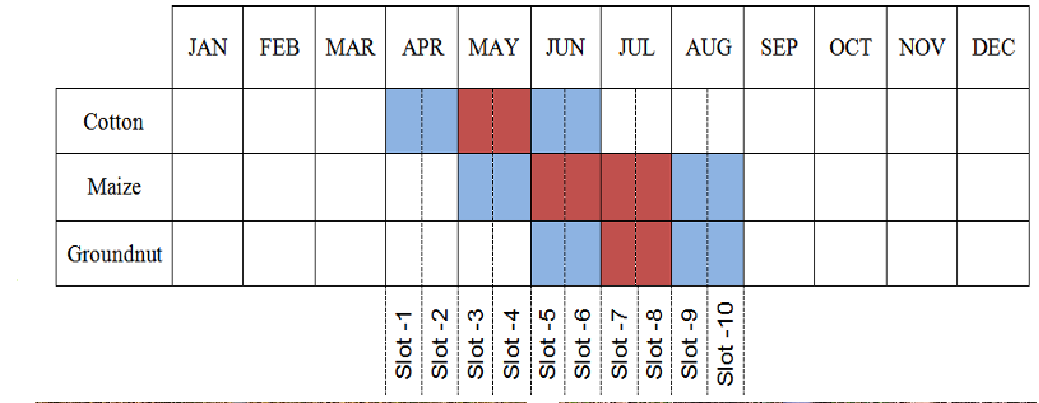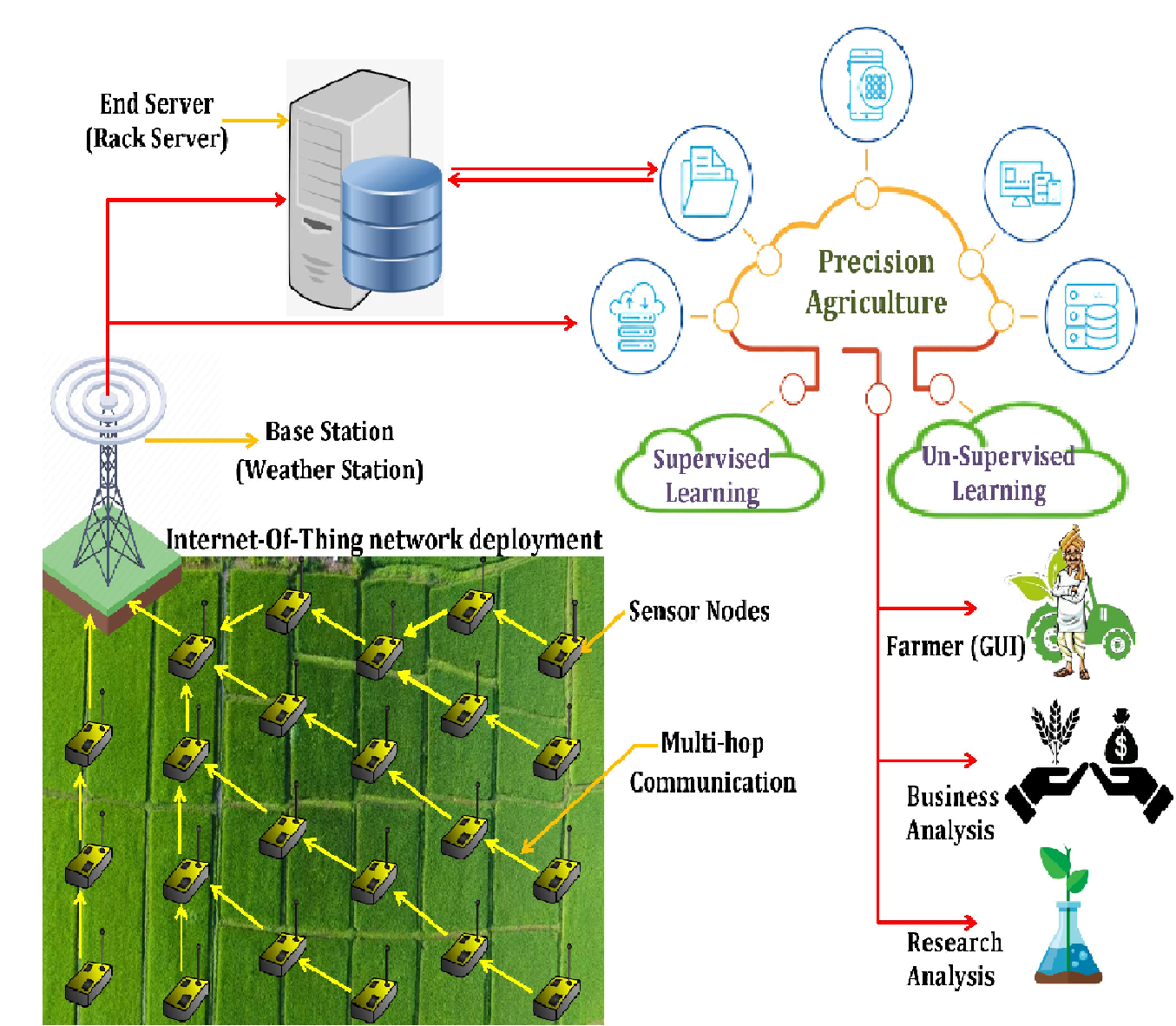Research Areas
Artificial intelligence & Machine learning, Data Analytics, Wireless sensor network, IoT & Edge Computing, Precision Agriculture, Big Data Processing
Current Research in Progress
Development of reliable proximal sensing technologies for forage height estimation
 PaddockTrac is a hardware module that measures the height of a pasture using ultrasonic time-of-flight (ToF) technology. It utilizes the time taken for a signal to travel from the sensor to the top of the canopy and back to calculate the height of the canopy. These height data are used to approximate biomass, similar to those produced by a rising plate meter.
PaddockTrac is a hardware module that measures the height of a pasture using ultrasonic time-of-flight (ToF) technology. It utilizes the time taken for a signal to travel from the sensor to the top of the canopy and back to calculate the height of the canopy. These height data are used to approximate biomass, similar to those produced by a rising plate meter. Read More
I am currently leading the development of a cyber-physical system that aims to optimize the use of grazing lands by providing accurate biomass estimates. Grazing lands cover most of the world's agricultural lands and play a crucial role in supplying feed for ruminant animals, carbon sequestration, and other ecosystem services. However, monitoring plant growth and estimating forage biomass is a complex and time-consuming task for land managers. The project I am working on combines machine learning, proximal and remote sensing, weather information, and other variables to better predict pasture biomass. While remote sensing data are useful for scaling biomass predictions, models relying solely on them often have high error levels, making predictions of dubious value to grazing land managers. My current project seeks to transform the management of grazing lands by providing the key data for better decisions and overcoming the barriers that prevent managers from adopting more effective management practices, with the final objective of allowing accurate biomass estimation. By integrating different technologies and data sources, I aim to provide an accessible and user-friendly tool that can assist land managers in improving their grazing land management practices, ultimately leading to better environmental and economic outcomes
Completed Research Work
IoT enabled WSN monitoring infrastructure driven Fuzzy-logic based Crop pest prediction
 Precision Agriculture, as the future of farming technology, addresses challenges faced by farmers by data-mining of information collected through IoT-enabled crop monitoring infrastructures. The identification of Crop disease is one of the widely studied challenges. Crop diseases cannot be accurately predicted by merely analyzing individual disease causes. The experiments are performed for pests in rice and millet crops. The Data-mining over samples collected in a cropping cycle revealed the plausible correlation between temperature, relative humidity, and rainfall with pest breeding. The data collected through IoT monitoring infrastructure is analyzed for the ambient breeding condition of the pest.
Precision Agriculture, as the future of farming technology, addresses challenges faced by farmers by data-mining of information collected through IoT-enabled crop monitoring infrastructures. The identification of Crop disease is one of the widely studied challenges. Crop diseases cannot be accurately predicted by merely analyzing individual disease causes. The experiments are performed for pests in rice and millet crops. The Data-mining over samples collected in a cropping cycle revealed the plausible correlation between temperature, relative humidity, and rainfall with pest breeding. The data collected through IoT monitoring infrastructure is analyzed for the ambient breeding condition of the pest. Read More
These conditions are then employed to design the knowledge base of the fuzzy system. More specifically, the linguistic variables of the fuzzy membership function are optimized using a genetic algorithm for close prediction of pest breeding in given environmental conditions. The work verified that the weather factors have a strong impact on the occurrence of pests and diseases, and the fuzzy logic-based pest predication through IoT application development services will help farmers to take precautionary measures beforehand. Despite using chemical pesticides and various non-chemical methods like crop rotation and genetic improvement of the crop, more than 40% of the total food produced is destroyed every year by weeds, molds, and other pests. As the world’s population has grown significantly and will continue to grow, by the middle of this century, it is estimated that the world will require more than 70% of its food. The use of pesticides and fungicides not only generates high costs for farmers but also pollutes the environment. The productivity and profitability of crops are reduced by all types of pathogens like insects, weeds, fungi, viruses, and mites. Therefore, usage should be reduced. In short, looking at the productivity and quality of crops, pollution, and pesticide costs, we can understand the importance of IoT Predictive Systems. Various works in the literature show the correlation between crop growth stages, weather conditions, and pest growing conditions. Despite the association between these three entities, there is no doubt that climate is a vital factor that operates between pests and crops. It is possible to develop a prediction system only after understanding this relationship to reduce pest growth. Various studies have reported that meteorological factors like rainfall, temperature, humidity, condensation, and precipitation have a direct influence on the pests growing conditions. Some analysis also states temperature and rainfall as significant factors for pest growth. For example, the growth of certain pests increases when the climate is hot and humid. It has also been observed that an increase in rainfall also helps in the spread of plant diseases. Hence, there is a need to monitoring meteorological data such as rain, moisture, and condensation to take beforehand preventive measures for the possible occurrence of the pest and frequency of pesticide and fungicide use.
Crop Plantation Correctness Index Identification
 There is a change in the climate in the past few decades. Various recent surveys and studies show the change in climatic conditions and this includes changes in the rainfall pattern, fluctuation in temperature, shifts in the timing of the season. As agriculture is dependent upon climate, the adverse effect of climate can be seen in agriculture; therefore, it is highly recommended to manage the resources according to the season shift for maximizing the crop yield.
There is a change in the climate in the past few decades. Various recent surveys and studies show the change in climatic conditions and this includes changes in the rainfall pattern, fluctuation in temperature, shifts in the timing of the season. As agriculture is dependent upon climate, the adverse effect of climate can be seen in agriculture; therefore, it is highly recommended to manage the resources according to the season shift for maximizing the crop yield. Read More
The weather directly influences agriculture, starting from the sowing of the seed to the harvest of the crop. Hence, well-planned and well-scheduled planting date is a must requirement for higher productivity; this will help efficient utilization of resources like water for irrigation, fertilizers, and pesticides and increase the farmers’ profit. At present, farmers generally follow a fixed planting schedule, which they are practicing for years. As there is a shift in the climatic conditions, a planting schedule based on the previous knowledge can lead to a decline in production, loss in labor cost, depletion of soil fertility, etc. The simplest way to face this challenge is to change the planting schedule. Considering the past year’s data and knowing the amount of climate shift can help in preparing a cropping schedule. Various studies also support the importance of selecting a correct planting date, which also helps in proper water management.
ML based sustainable precision agriculture:
 Precision agriculture is a practice where the agricultural activities are carried out accurately and controlled so that the crop yield can be maximized without exploiting the available resources. To maximize crop yield, fields are deployed with sensor nodes, which are used to collect data related to the farm to perform analytical processing of the collected data. These nodes are connected to the base station, which sends the collected data to the final server from where the data is moved to various data storage and data processing platforms. Further, data processing is done, and machine learning algorithms are applied to gain insight within the data. The analysis helps develop farmer-friendly and interactive GUI, through which useful farm-related tips and instruction are provided. Various research and business analytics are also carried out with the help of machine learning.
Precision agriculture is a practice where the agricultural activities are carried out accurately and controlled so that the crop yield can be maximized without exploiting the available resources. To maximize crop yield, fields are deployed with sensor nodes, which are used to collect data related to the farm to perform analytical processing of the collected data. These nodes are connected to the base station, which sends the collected data to the final server from where the data is moved to various data storage and data processing platforms. Further, data processing is done, and machine learning algorithms are applied to gain insight within the data. The analysis helps develop farmer-friendly and interactive GUI, through which useful farm-related tips and instruction are provided. Various research and business analytics are also carried out with the help of machine learning. Read More
Time is short, and if the fundamental scientific knowledge is as yet so incomplete that it cannot point immediately to the best solution to any specific problem, at the very least it should be adequate to avoid errors. The cost of the mis-use of land is no longer measured in terms of money, but in human lives. The “Internet of Things” (IoT) is a highly promising family of technologies which is capable of offering many solutions towards the modernization of agriculture. Scientific groups and research institutions, as well as the industry, are in a race trying to deliver more and more IoT products to the agricultural business stakeholders, and, eventually, lay the foundations to have a clear role when IoT becomes a mainstream technology. At the same time Cloud Computing, which is already very popular, and Fog Computing provide sufficient resources and solutions to sustain, store and analyses the huge amounts of data generated by IoT devices. The management and analysis of IoT data (“Big Data”) can be used to automate processes, predict situations and improve many activities, even in real-time. Moreover, the concept of interoperability among heterogeneous devices inspired the creation of the appropriate tools, with which new applications and services can be created and give an added value to the data flows produced at the edge of the network. The agricultural sector was highly affected by Wireless Sensor Network (WSN) technologies and is expected to be equally benefited by the IoT.
